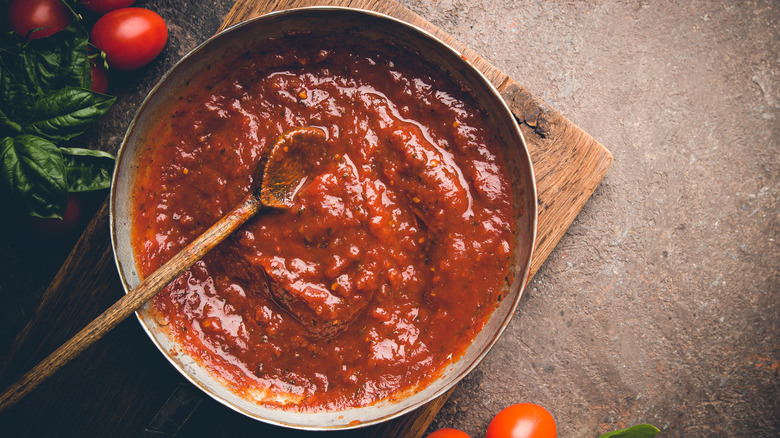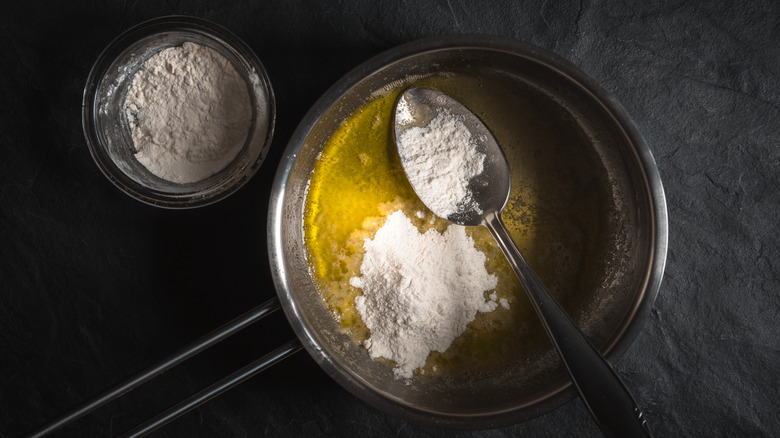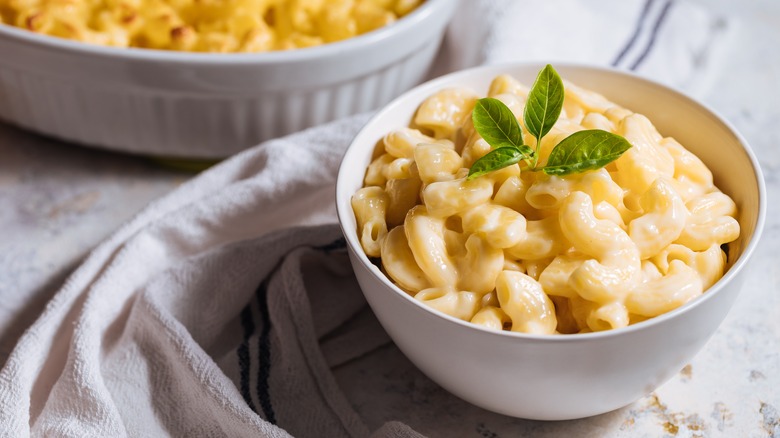The Top Tips For Avoiding Lumps When Thickening Pasta Sauce With Slurry Or Roux
Whether you're making a zingy red sauce or a creamy alfredo, the key to most great pasta sauces is achieving the right thickness. To thicken a sauce enough to cling wonderfully to any pasta shape or size, it's common to incorporate starch in the form of a slurry (equal parts water and starch) or roux (equal parts fat and flour, cooked until nutty and fragrant). Though the cooking occasions and preparation for each technique vary, one thing is true when thickening pasta sauce with either method: to avoid lumps of starch, add your roux or slurry in gradually while whisking constantly.
If you've ever tried to add flour or cornstarch directly into a pot of pasta sauce or stew, you've probably seen flour or starch clumps that just won't dissolve — in effect, ruining your sauce. To avoid this, in a roux, butter or oil is used to coat and disperse the starch granules so they can evenly distribute in sauces without congealing and forming those dreaded lumps. The same goes for starch's dispersion in water in a slurry.
This distribution of starch granules helps them properly gelatinize (without conglomerating) and soak up the sauce's excess liquid, making it thicker. To keep these dispersion qualities so that your sauce can thicken, you must add your roux or slurry in carefully. Whisk in the starchy solution little by little, stirring thoroughly and constantly to ensure it gets mixed in.
Whisk in a roux or slurry gradually, and pay mind to temperature
To avoid flour lumps in your pasta sauce, it's crucial to add slurry or roux into your sauce gradually at the right time in the cooking process. To prepare a roux, add an equal portion of flour to melted butter in a saucepan, whisking it constantly so it doesn't burn. For a white roux, which is commonly used to make creamy sauces like bechamel or alfredo, cook the flour and butter mixture for about 5 minutes, or until it starts to bubble.
When working with a roux, the temperature of your sauces and liquids is important. Gradually add cold or room temperature liquids like milk to a hot roux, so it disperses. Alternately, to add a roux to a hot pot of tomato sauce, you must first cool the roux down so it incorporates without clumping. Add just enough of the starchy paste to thicken your sauce, then let it simmer for an additional 10 or 15 minutes to fully thicken.
Slurries are a bit more simple when it comes to preparation and addition. Just thoroughly mix equal parts starch and water, and whisk in a tablespoon of the starchy liquid to your sauce just before it's done cooking. It will thicken almost instantly, so mix it in completely, let it simmer for a minute, then take the sauce off the heat.
How to choose the best thickening method for your sauce
For creamy sauces like those used for rich homemade mac and cheese, a roux is a common sauce-thickening technique you can count on in most recipes. Roux keeps well in the fridge or freezer, so you can easily make a batch to have on hand as needed for a variety of pasta sauces, stews, and soups. While you can use a roux to thicken a hearty tomato sauce, if you don't have any or don't feel like making one, you can also whip up a slurry. The method is quicker and requires less simmering time for the starches to do their work in thickening the sauce. While some home chefs choose to whisk together equal parts cornstarch and water for their tomato sauce slurry, the cornstarch isn't especially strong in acidic sauces, so you'll have to pay mind to cook time and simmer just for a minute or two at the end of the sauce's cooking. However, if you have arrowroot, tapioca, or potato starch on hand, these will hold up better in tomato sauce.
Either way, start by adding just a tablespoon of slurry (or roux if you have it prepared) and constantly whisk the starch mixture into your sauce until it's fully combined, with no lumps in sight. Add just enough to get your sauce to your desired thickness. Remember, you can always add more slurry or roux to your pasta sauce, but you can't remove it.


